Bayesian networks (also called belief networks, Bayesian belief networks, causal probabilistic networks, or causal networks) (Pearl 1988) are acyclic directed graphs in which nodes represent random variables and arcs represent direct probabilistic dependences among them. The structure of a Bayesian network is a graphical, qualitative illustration of the interactions among the set of variables that it models. The structure of the directed graph can mimic the causal structure of the modeled domain, although this is not necessary. When the structure is causal, it gives a useful, modular insight into the interactions among the variables and allows for prediction of effects of external manipulation.
The name Bayesian originates from the fact that the joint probability distribution represented by a Bayesian network is subjective (please recall that they are sometimes called belief networks; Bayesian approach is often used as a synonym for subjective view on probability) and this subjective probability distribution can be updated in the light of new evidence using Bayes theorem.
Bayesian networks: The theoretical minimum
Bayesian networks are acyclic directed graphs that represent factorizations of joint probability distributions. Every joint probability distribution over n random variables can be factorized in n! ways and written as a product of probability distributions of each of the variables conditional on other variables. Consider a simple model consisting of four variables Socio-Economic Status (E), Smoking (S), Asbestos Exposure (A), and Lung Cancer (C). The joint probability distribution over these four variables can be factorized in 4!=24 ways, for example,
Pr(E,S,A,C)=Pr(E|S,A,C) Pr(S|A,C) Pr(A|C) Pr(C)
Pr(E,S,A,C)=Pr(E|S,A,C) Pr(S|A,C) Pr(C|A) Pr(A)
Pr(E,S,A,C)=Pr(E|S,A,C) Pr(S|A,C) Pr(A|C) Pr(C)
…
Pr(E,S,A,C)=Pr(C|E,S,A) Pr(A|E,S) Pr(S|E) Pr(E)
…
Pr(E,S,A,C)=Pr(C|E,S,A) Pr(A|E,S) Pr(S|E) Pr(E)
Each of these factorizations can be represented by a Bayesian network. We construct the directed graph of the network by creating a node for each of the factors in the distribution (we label each of the nodes with the name of a variable before the conditioning bar) and drawing directed arcs between them, always from the variables on the right hand side of the conditioning bar to the variable on the left hand side. For the first factorization above
Pr(E,S,A,C)=Pr(E|S,A,C) Pr(S|A,C) Pr(A|C) Pr(C)
we will construct the following Bayesian network
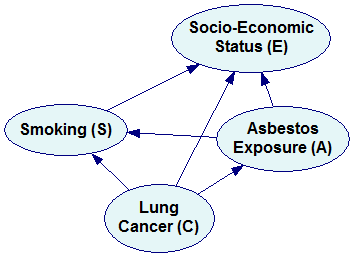
The fourth factorization
Pr(E,S,A,C)=Pr(C|E,S,A) Pr(A|E,S) Pr(S|E) Pr(E)
will yield the following Bayesian network
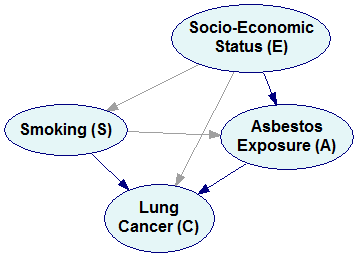
Please note that we have an arc from E to S because there is a factor Pr(S|E) in the factorization. Arcs from S, E, and A to C correspond to the factor Pr(C|E,S,A).
A graph tells us much about the structure of a probabilistic domain but not much about its numerical properties. These are encoded in conditional probability distribution matrices (equivalent to the factors in the factorized form), called conditional probability tables (CPTs) that are associated with the nodes. It is worth noting that there will always be nodes in the network with no predecessors. These nodes are characterized by their prior marginal probability distribution. Any probability in the joint probability distribution can be determined from these explicitly represented prior and conditional probabilities.
For the network above, we will have the following CPTs for the nodes E, S, A and C respectively:
![]()
![]()


A straightforward representation of the join probability distribution over n binary variables requires us to represent the probability of every combination of states of these variables. For n binary variables, for example, we have 2n-1 such combinations. In the example network above, we need 24-1=15 numerical parameters. While there are 30 numbers in the four tables above, please note that half of them are implied by other parameters, as the sum of all probabilities in every distribution has to be 1.0, which makes the total number of independent parameters equal to 15.
Now, suppose that we know that Socio-Economic Status and Smoking are independent of each other. If so, then knowing whether somebody is educated or not tells us nothing about this person's smoking status. Formally, we have Pr(S|E)=Pr(S). This allows us to simplify the factorization to the following
Pr(E,S,A,C)=Pr(C|E,S,A) Pr(A|E,S) Pr(S) Pr(E)
Similarly, suppose that we know that Asbestos Exposure and Smoking are independent of each other. If so, then knowing whether somebody smokes or not tells us nothing about this person's exposure to asbestos. Formally, we have Pr(A|S)=Pr(A). This allows us to further simplify the factorization to the following
Pr(E,S,A,C)=Pr(C|E,S,A) Pr(A|E) Pr(S) Pr(E)
Finally, supposed that we realize that knowledge of Smoking status and Asbestos Exposure makes Socio-Economic Status irrelevant to the probability of Cancer, i.e., Pr(C|E,S,A)= Pr(C|S,A). We can simplify the factorization further to
Pr(E,S,A,C)=Pr(C|S,A) Pr(A|E) Pr(S) Pr(E)
The Bayesian network representing the simplified factorization looks as follows
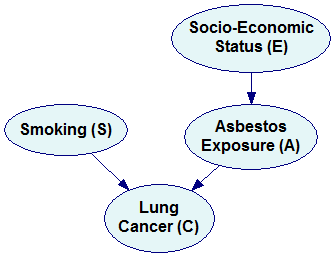
Please note that the new network is missing three arcs compared to the original network (marked by dimmed arcs in the previous pictures). These three arcs correspond to three independences that we encoded in the simplified factorization. It is a general rule that every independence between a pair of variables results in a missing arc. Conversely, if two nodes are not directly connected by an arc, then there exists such set of variables in the joint probability distribution that makes them conditionally independent. A possible interpretation of this is that the variables are not directly dependent. If we need to condition on other variables to make them independent, then they are indirectly dependent.
Let us look at the conditional probability tables encoded in the simplified network
![]()
![]()
![]()

This simpler network contains fewer numerical parameters, as the CPTs for the nodes Smoking, Lung Cancer and Asbestos Exposure are smaller. The total number of parameters is 16 and the total number of independent parameters is only 8. This reduction in the number of parameters necessary to represent a joint probability distribution through an explicit representation of independences is the key feature of Bayesian networks.
Of all the factorizations possible, those that are capable of representing all independences known in the domain are preferable. Please note that the three independences that we were aware of, Pr(S|E)=Pr(S), Pr(A|S)=Pr(A) and Pr(C|E,S,A)= Pr(C|S,A) could not be captured by each of the possible factorizations. For example, in case of the first factorization
Pr(E,S,A,C)=Pr(E|S,A,C) Pr(S|A,C) Pr(A|C) Pr(C)
there is no way we could capture the independence Pr(C|E,S,A)= Pr(C|S,A) and the factorization can be simplified to only
Pr(E,S,A,C)=Pr(E|A,C) Pr(S|C) Pr(A|C) Pr(C)
which corresponds to the following Bayesian network
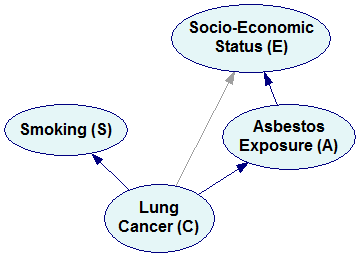
Using independences to simplify the graphical model is a general principle that leads to simple, efficient representations of joint probability distributions. As an example, consider the following Bayesian network, modeling various problems encountered in diagnosing Diesel locomotives, their possible causes, symptoms, and test results (included among the example networks as MachineDiagnosis.xdsl)
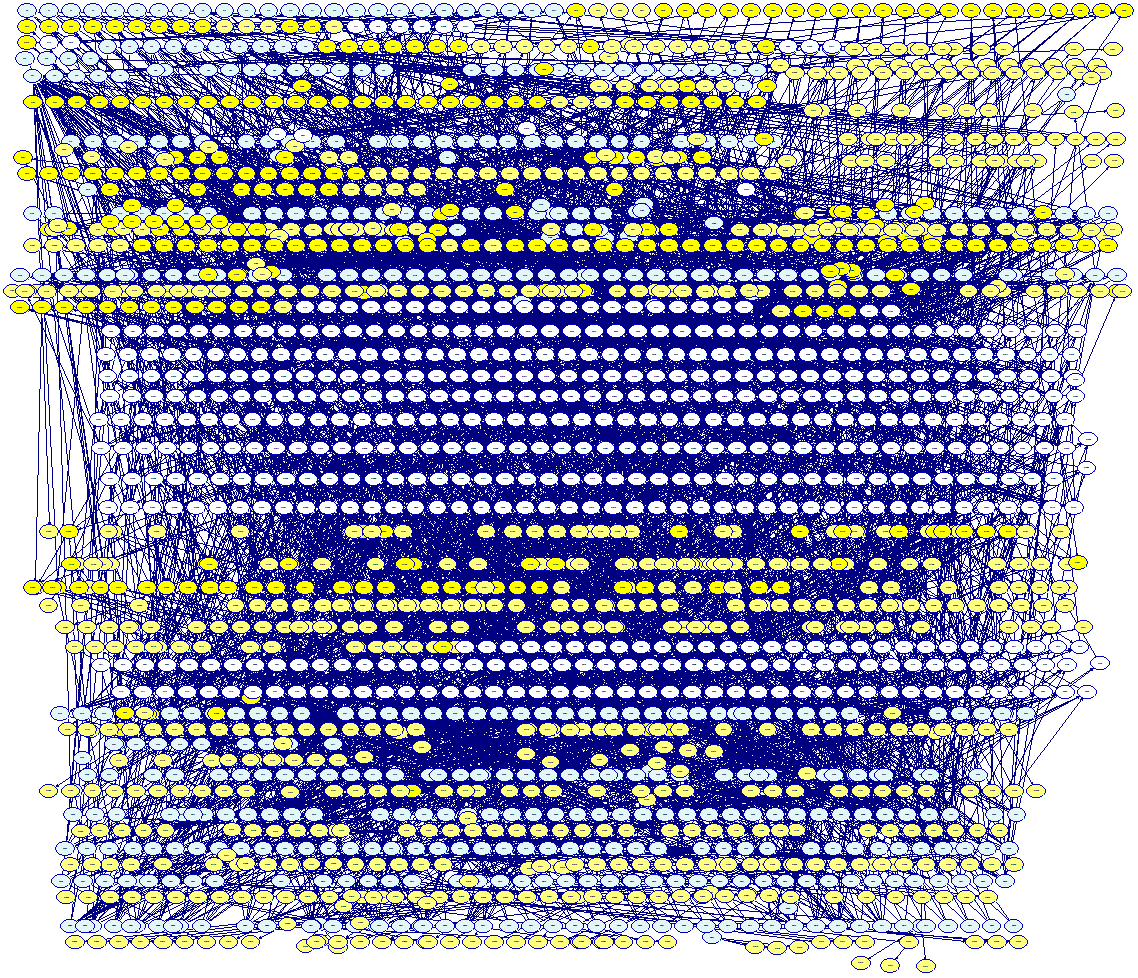
This network contains 2,127 nodes, i.e., it models a joint probability distribution over 2,127 variables. Given that each of the variables is binary, to represent this distribution in a brute force way, we would need 22127 (which is around 10632) numbers. To make the reader aware of the magnitude of this number, we would like to point out that the currently held estimate for the number of atoms in the universe is merely 1082, which is 550 orders of magnitude (!) smaller than 10632, i.e., it would require as many parameters as the number of atoms in 10550 universes like ours. The model pictured above is represented by only 6,433 independent parameters. As we can see, representing joint probability distributions becomes practical and models of the size of the example above are not uncommon.
Deterministic nodes
Deterministic nodes, usually drawn as double-circles or double-ovals, represent either constant values or values that are algebraically determined from the states of their parents. In other words, if the values of their parents are known, then the value of a deterministic node is also known with certainty. Deterministic nodes are quantified similarly to Chance nodes. The only difference is that their probability tables contain all zeros and ones (note that there is no uncertainty about the outcome of a deterministic node once all its parents are known).
Bayesian networks: A less formal (although also perfectly sound) view
The purely theoretical view that Bayesian networks represent independences and that lack of an arc between any two variables X and Y represents a (possibly conditional) independence between them, is not intuitive and convenient in practice. A popular, slightly informal view of Bayesian networks is that they represent causal graphs in which every arc represents a direct causal influence between the variables that it connects. A directed arc from X to Y captures the knowledge that X is a causal factor for Y. While this view is informal and it is easy to construct mathematically correct counter-examples, it is convenient and widely used by almost everybody applying Bayesian networks in practice. There is a well-established assumption (known as the Causal Markov Condition), with no convincing counter-examples, that causal graphs will automatically lead to correct patterns of independences. Please recall the Bayesian network constructed in the previous section. Its arcs correspond to the intuitive notions that Smoking and Asbestos Exposure can cause Lung Cancer and that Socio-Economic Status influences Asbestos Exposure. Lack of arcs between pairs of variables expresses simple facts about absence of causal influences between them. Independences between these pairs of variables follow from the structure of the graph. It is, thus, possible to construct Bayesian networks based purely on our understanding of causal relations between variables in our model.
Both, the structure and the numerical parameters of a Bayesian network, can be elicited from an expert. They can also be learned from data, as the structure of a Bayesian network is simply a representation of independences in the data and the numbers are a representation of the joint probability distributions that can be inferred from the data. Finally, both the structure and the numerical probabilities can be based on a mixture of expert knowledge, measurements, and objective frequency data.
Reasoning with Bayesian networks
Structural properties of Bayesian networks, along with the conditional probability tables associated with their nodes allow for probabilistic reasoning within the model. Probabilistic reasoning within a BN is induced by observing evidence. A node that has been observed is called an evidence node. Observed nodes become instantiated, which means, in the simplest case, that their outcome is known with certainty. The impact of the evidence can be propagated through the network, modifying the probability distribution of other nodes that are probabilistically related to the evidence. For the example network, modeling various causes of Lung Cancer, we can answer questions like What is the probability of lung cancer in an educated smoker?, What is the probability of asbestos exposure in a lung cancer patient?, or Which question should we ask next?
In case of the first question, we instantiate the variables Smoking and Socio-Economic Status to S and Educated respectively and perform update of the network. The evidence entered can be visualized as spreading across the network.
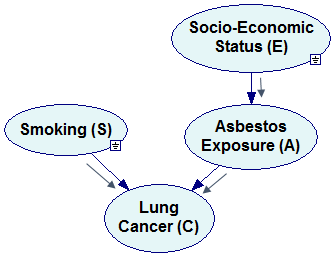
This process amounts at the foundations to a repetitive application of Bayes theorem in order to update the probability distributions of all nodes in the network. Different ways of applying Bayes theorem and different order of updating lead to different algorithms. Essentially, the existing algorithms for inference in Bayesian networks can be divided into three groups: message passing, graph reduction, and stochastic simulation. Explicit representation of independences allows for an increased computational tractability of probabilistic reasoning. Probabilistic inference in singly connected BNs is very efficient. Unfortunately, exact algorithms for multiply connected networks are liable to exponential complexity in the number of nodes in the network. Cooper (1990) has shown that the problem is NP-hard in general. Still, efficient software, like SMILE, offers reasonable computing times even in networks consisting of thousands of nodes, like the network for the diagnosis of Diesel locomotives illustrated above.
The following pair of graphs illustrates this process. It is our example network but all nodes in the graph are viewed as "bar charts" expressing marginal probability distributions over the nodes.
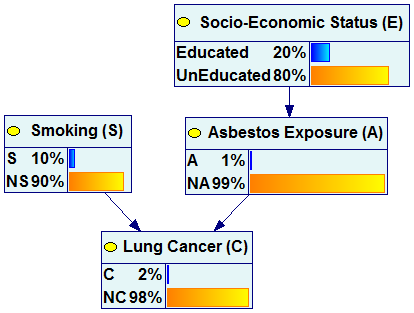
![]()
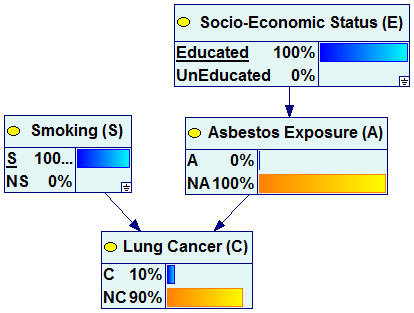
We can see that once the observation of smoking and education have been made, the marginal probability of C (Lung Cancer present) changes from 2% (a-priori probability) to 10% (a-posteriori probability).
Complex models allow for asking questions similar to the ones asked of the simple example network. And so, in case of the Diesel locomotives example, we can ask the probability of any fault given a set of symptoms or test results, we can ask for the most probable faults, and the most effective questions to be posed in order to reach a final diagnosis.
The following network (included among the examples as HeparII.xdsl) models common diseases of the liver.
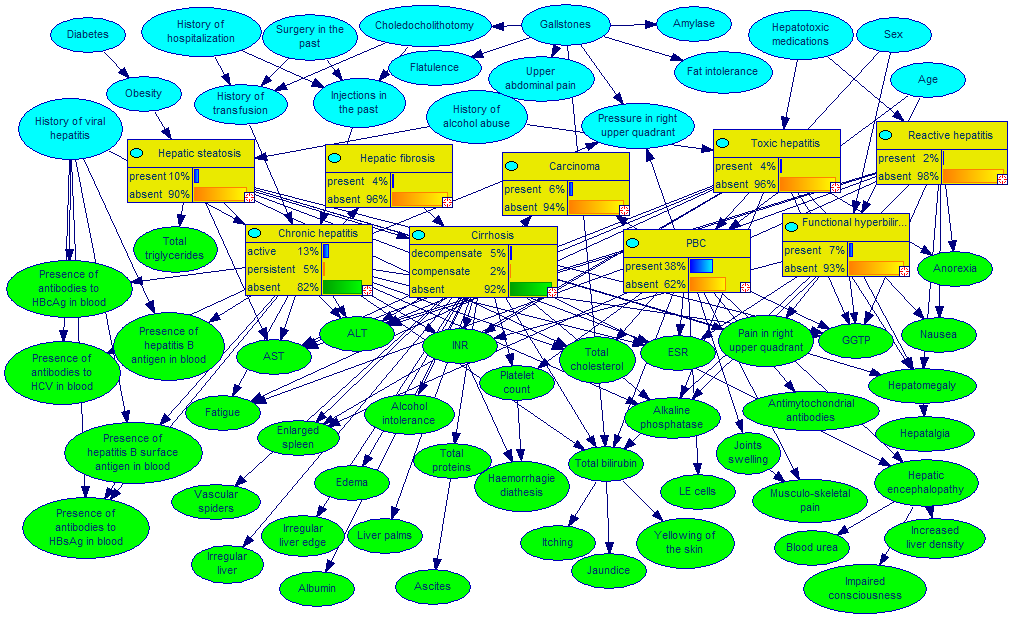
Special diagnostic dialog allows for viewing the diseases (upper-left pane) from the most to least likely and the possible observations and medical tests rank-ordered from the most to least informative given the current patient case.
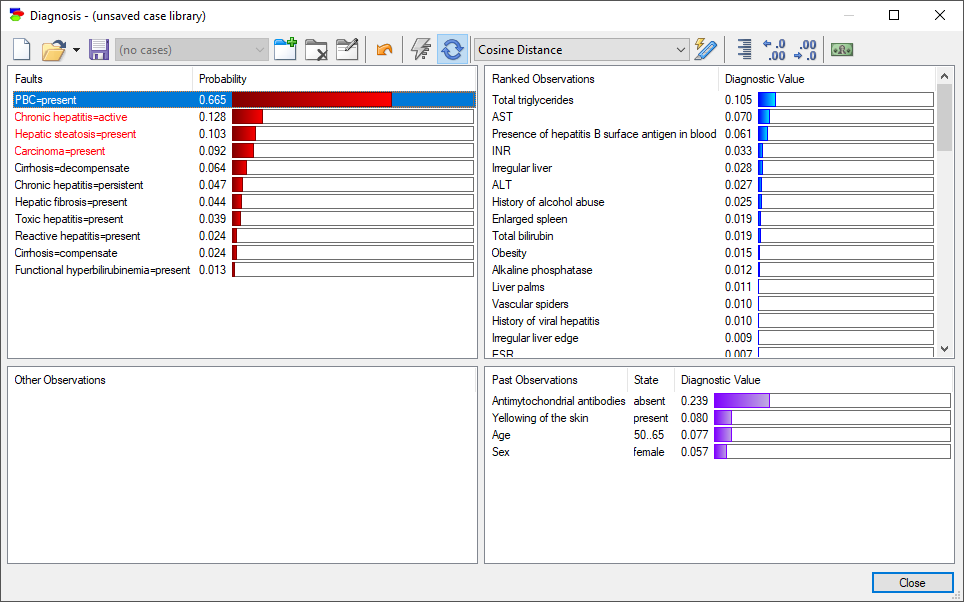
This is all straightforward to compute from the joint probability distribution represented by the Hepar II model.